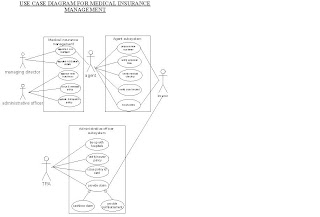uml diagrams for medical insurance management
the diagrams in this blog for medical insurance management....
Dedication to my respectful uml-lab madam
hosting an uml-diagrams successfully is dedicated to my most respectful and honorable
proffessor vanitha sidambaranathan
who is my uml-lab madam and who motivated and guided
me to get a good idea in uml diagrams..
I sincerely thankful to my madam for giving this opportunity in my life...
sequence diagram

purpose
UML sequence diagrams are used to represent or model the flow of messages, events and actions between the objects or components of a system. Time is represented in the vertical direction showing the sequence of interactions of the header elements, which are displayed horizontally at the top of the diagram.
state diagram

purpose
Statechart diagram describes the flow of control from one state to another state. States are defined as a condition in which an object exists and it changes when some event is triggered. So the most important purpose of Statechart diagram is to model life time of an object from creation to termination.
state diagram

purpose
Statechart diagram describes the flow of control from one state to another state. States are defined as a condition in which an object exists and it changes when some event is triggered. So the most important purpose of Statechart diagram is to model life time of an object from creation to termination.
activity diagram

purpose
Activity diagrams are graphical representations of workflows of stepwise activities and actions with support for choice, iteration and concurrency.[1] In the Unified Modeling Language, activity diagrams can be used to describe the business and operational step-by-step workflows of components in a system. An activity diagram shows the overall flow of control.
usecase diagram

purpose
A use case diagram in the Unified Modeling Language (UML) is a type of behavioral diagram defined by and created from a Use-case analysis. Its purpose is to present a graphical overview of the functionality provided by a system in terms of actors, their goals (represented as use cases), and any dependencies between those use cases.
The main purpose of a use case diagram is to show what system functions are performed for which actor. Roles of the actors in the system can be depicted.
Subscribe to:
Posts (Atom)
